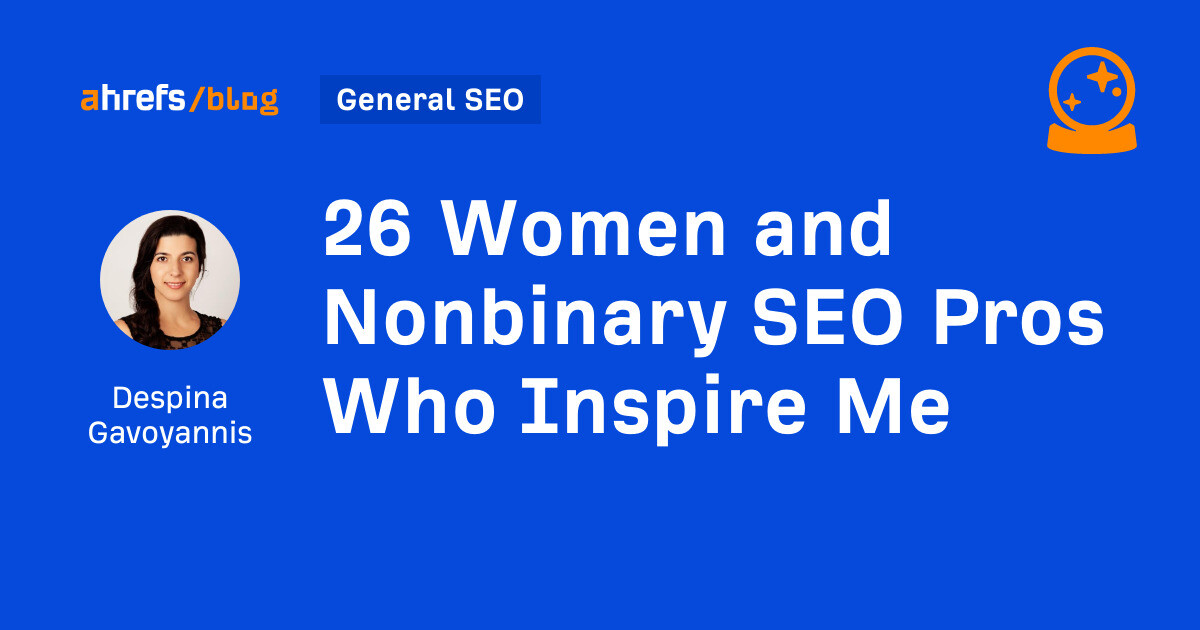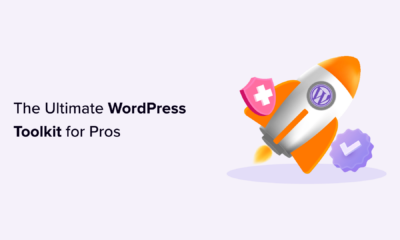SEO
26 Women and Nonbinary SEO Pros Who Inspire Me

In the lead-up to International Women’s Day, I started reflecting on all the amazing women and nonbinary folks in our industry who I have learned from and who continuously inspire me in my career.
Here are the top 26 whose expertise, results, and insights I greatly admire and think you will, too.
Make sure you check them all out. Anyone who has seen me eat a delicious meal knows I save the best til last, and this list is no different.
But let’s also be real for a moment…
I’m totally aware that many of the people who’ve inspired me are the big names you see on a lot of these sorts of lists. That’s just the nature of life.
And there are obviously loads of super smart, but lesser known, women and nonbinary folks in SEO who deserve attention too… so I also asked my friends and colleagues for shoutouts on who inspires them and rounded their suggestions up in an epic MEGA list of 99+ inspiring SEO experts we think you should follow.
Talent transcends borders, and so does this list. Like it, share it, repost it, but above all, follow and support all the experts you see here.
SEO Consultant @ Orainti
What she’s known for: Technical SEO, international SEO
Where to follow her: Twitter, LinkedIn
My fave takeaways: Everything. Literally everything. But if I had to pick one, it would be Aleyda’s free SEO roadmap on learningseo.io. If by some miracle you aren’t already familiar with Aleyda’s work, she freely and frequently shares a ton of knowledge bombs on all things technical SEO, enterprise-level skills and general tips for SEO professionals.
Owner @ Marie Haynes Consulting


What she’s known for: Google penalty recovery, how Google’s algorithm works
Where to follow her: Twitter, LinkedIn
My fave takeaways: Marie’s Google algorithm update list is so good, I check it out every time (yes, every. single. time.) I run a traffic loss audit or want additional context on the latest updates. I also love her insights on penalty recoveries and understanding Google’s Quality Rater Guidelines shared in her Search News You Can Use newsletter.
CEO @ Keylime Toolbox


What she’s known for: Creating Google Webmaster Central, developing search patents
Where to follow her: Twitter, LinkedIn
My fave takeaways: Vanessa is an ex-Googler and has done some seriously cool things in the SEO space that don’t get enough attention, in my opinion. Check out her patents, book, and read her speaker bio for everything else.
Vice President of SEO Strategy & Research @ Amsive Digital


What she’s known for: E-E-A-T, Google core algorithm insights
Where to follow her: Twitter, LinkedIn
My fave takeaways: Firstly, I love her rockstar vibe (I mean, who doesn’t?). Professionally, Lily’s take on E-E-A-T is very insightful and aligns with what I’ve also seen with my clients. I also love the insights she shares on why Google just may not be into your site and what’s really up when it comes to core algorithm traffic losses.
Independent Marketing Consultant


What she’s known for: SEO futurist, entity optimization
Where to follow her: Twitter, LinkedIn
My fave takeaways: If you ever have the chance to see Jes present live, take it. She is an absolute powerhouse, sharing a wealth of knowledge about where Google and the future of search are heading. In particular, I love her tips on owning your brand entity and optimizing it so it’s Google-friendly.
Co-Founder @ Fractl


What she’s known for: Digital PR, SEO automation with GPT4
Where to follow her: LinkedIn
My fave takeaways: Kristin delivers so much value through her free scripts that automate many aspects of SEO. I recommend starting with this list of 20+ scripts. But you should also check out everything else she shares. You can thank me later.
CEO @ SEO In House


What she’s known for: Enterprise SEO, executive SEO
Where to follow her: Twitter, LinkedIn
My fave takeaways: Jessica wrote the book on Executive SEO and I highly recommend it if you’re an in-house SEO or offering enterprise services. My biggest takeaway—that I often reflect on deep into the hours of sleepless nights even years after reading the book—is the concept of becoming an “SEO pacesetter.” If the organizations we work in unified all teams around SEO, imagine the pure potential that would be ripe for the picking. Jessica’s book helps make that potential a reality.
Chief Content Officer @ MarketingProfs


What she’s known for: Creating “ridiculously good content,” escaping “marketing mediocrity”
Where to follow her: Twitter, LinkedIn
My fave takeaways: Can you be a writer or marketer and not be at least a little in love with Ann’s philosophy? As the world’s first Chief Content Officer, we all have a lot to learn from her about creating content that truly stands out online. Ann’s been sharing great insights for years. If you’re new to her work, I recommend starting with her books Everybody Writes and Content Rules.
Senior Technical Consultant @ Dejan Marketing


What she’s known for: Technical SEO, SGE Research
Where to follow her: Twitter, LinkedIn
My fave takeaways: I LOVED Nik’s presentation at the 2023 Singapore SEO Summit. She shared loads of search generative experience (SGE) knowledge bombs, data about how AI may change the SERPs and what that means for brand visibility from search-based channels. If you haven’t taken SGE out for a spin yet, check out Nik’s two-minute SGE guide to get you started (from anywhere in the world).
Owner + Link Builder @ BibiBuzz


What she’s known for: Link Building
Where to follow her: Twitter, LinkedIn
My fave takeaways: Not only is Bibi an awesome human sharing good vibes, she’s also a damn good link builder praised for her ability to share actionable, helpful information about all things link building. Check out her entire process here.
Global SEO Lead @ Kurt Geiger


What she’s known for: Global SEO, Enterprise SEO
Where to follow her: Twitter, LinkedIn
My fave takeaways: I’m a huge fan of cross-collaboration between SEO and non-SEO teams to achieve meaningful outcomes. So it’s no surprise why Maria’s ability to work cross-functionally in large organizations inspires me to no end. It really is not an easy feat, yet she sure makes it look effortless. There’s also a lot more to learn from her if you aspire to a leadership position in the industry as an in-house SEO like how to make better reports for your c-suite or turning data into impact.
Founder @ Marketing Syrup


What she’s known for: Technical SEO Educator
Where to follow her: Twitter, LinkedIn
My fave takeaways: If you’re looking for quality education on advanced technical SEO skills, Kristina’s content and courses are a great place to start. Prior to my career in SEO, I was an educator and have not been able to ignore the education crisis our industry experiences. There really is a lack of beginner-friendly yet expert education for skills that can be difficult to master. If you’re tired of teaching yourself every little thing about technical SEO (and constantly wondering if you’re doing it right), do yourself a favor and check out Kristina’s courses instead. You’re welcome.
Technical SEO Consultant @ Not a Robot


What they’re known for: Technical SEO, JavaScript wrangling
Where to follow them: Twitter, LinkedIn
My fave takeaways: If you’re into nerding out over SEO, good storytelling, and you enjoy a decent splash of snark, you’ve got to check out Jamie’s content. From their delightfully fun feature on SEO fairytales to sharing their experience wrangling messy JS or auditing large websites to bite-sized commentary in the Rich Snippets newsletter, Jamie shares a ton of golden nuggets.
Head of SEO Communications @ Wix


What she’s known for: SEO Communications, big-brand SEO
Where to follow her: Twitter, LinkedIn
My fave takeaways: I love Crystal’s ability to take a technical SEO concept, like structured data, and communicate its strategic value in a way business owners can understand, like in this post. As SEO professionals, we need to do more of this if we want to increase our odds of getting buy-in for SEO initiatives.
CEO + SEO Consultant @ SEOSLY


What she’s known for: Comprehensive technical SEO guides + templates
Where to follow her: Twitter, LinkedIn
My fave takeaways: Olga shares many comprehensive step-by-step technical SEO checklists and templates that really are a one-stop shop. If you’re new to SEO and want the confidence you’re not missing out on any vital steps during audits, or you’d like an expert’s tips on exactly how they use SEO tools in their processes, I recommend checking out Olga’s blog starting with this post on how to audit your site with Ahrefs.
Senior Content Marketing Manager @ Moz


What she’s known for: SEO content strategy, SaaS content
Where to follow her: Twitter, LinkedIn
My fave takeaways: Chima’s tips on content strategy that delivers results are a dream. I especially love it when she shares a behind-the-scenes view of her process, like in this post sharing how she tackles content briefing. I’ve learned so much from Chima over the years and am sure you will too.
Business Consultant @ Britney Muller Inc


What she’s known for: AI + LLMs, Data Science for SEO
Where to follow her: Twitter, LinkedIn
My fave takeaways: I’ve been following Britney’s work since she was a Senior SEO Scientist at Moz. Recently, her work and interests have focused on education around data science, AI, LLMs, and all these hot topics taking the SEO world by storm. I especially love her ability to explain emerging technology in a beginner-friendly way (like her post explaining Google’s ML model BERT or her website making machine learning accessible for marketers).
Head of Marketing @ Elevar


What she’s known for: Google Analytics, marketing attribution, data for SEO
Where to follow her: Twitter, LinkedIn
My fave takeaways: If GA4 and attribution models do your head in, check out Kayle’s Analytics in Minutes YouTube channel. I also recommend checking out her guides on using GA4, SEO analytics, and the top three GA metrics worth tracking.
Web Infrastructure + Intelligence Lead @ Uber


What she’s known for: In-house SEO, Getting buy-in for SEO
Where to follow her: Twitter, LinkedIn
My fave takeaways: Jackie shares some great insights for in-house and non-in-house SEO pros alike. From tips on how to get buy-in for SEO initiatives in a large organization to how to IPO as an SEO, there’s a lot to learn here. I also love her take on how SEO is not a black box because it really isn’t, and it’s our job to educate non-SEO stakeholders about it.
CMO, Board Member, Advisor & Angel Investor


What she’s known for: Executive SEO, angel investing
Where to follow her: Twitter, LinkedIn
My fave takeaways: Joanna has held multiple executive-level marketing positions, including a stint at Moz. I love seeing how leaders like Joanna think and approach various challenges at an executive level, and if you do too, give her a follow. I especially love her hot take that what makes a great brand includes “fighting for your customer and championing something bigger than yourself.”
Head of Search & SEO @ Alamy


What she’s known for: Technical SEO, Image SEO
Where to follow her: Twitter, LinkedIn
My fave takeaways: Roxana has an incredible mind for analytics and technical, data-driven work. With a background in mathematics, she really knows her stuff when it comes to technical SEO. I recommend checking out her technical SEO tips in a free course shared with the Freelance Coalition as well as her next-level image SEO insights from her presentation at LondonSEO XL 2023.
General Manager of Agency Services @ EngineRoom


What she’s known for: SEO leadership, SEO agency management
Where to follow her: LinkedIn
My fave takeaways: Sam and I have had the pleasure of working together for many years in the first female-led SEO team I’ve been a part of in any agency. We’re quite proud of this feat and have transformed our team, consisting mainly of non-SEO professionals, into an SEO powerhouse delivering super-cool results for clients. If you aspire to step into agency leadership roles, Sam has a wealth of knowledge and experience you can learn from.
Founder @ Flow SEO


What she’s known for: SaaS SEO
Where to follow her: Twitter, LinkedIn
My fave takeaways: I met Viola very early in my SEO journey and have enjoyed watching as her career transformed over the years. I love the philosophies she shares about issues beyond SEO that are central to the day-to-day lives of anyone working in startups and scaleups. Check out her podcast for inspiring conversations about things like finding flow, conscious leadership, and more.
Founder @ Women in Tech SEO


What she’s known for: Building a community for women in SEO
Where to follow her: Twitter, LinkedIn
My fave takeaways: Areej is renowned for her work supporting women in SEO through her Women in Tech SEO social and Slack groups. She also runs community events, and free mentorships and promotes other women in the industry in multiple ways. For instance, you can find female speakers, founders, and freelancers on her website.
CEO @ The Content Factory


What she’s known for: Digital PR, remote work
Where to follow her: Twitter, LinkedIn
My fave takeaways: Kari’s been sharing her journey on running a remote digital agency since well before the pandemic made it common practice. I always find her insights on how she’s grown a multi-million dollar remote agency very insightful. She also manages Sisters in SEO where she frequently shares fair and inclusive job opportunities along with down-to-earth SEO advice.
Founder @ Oree Virtual


What they’re known for: Making the web a more inclusive space
Where to follow them: Samantha is no longer on social media, though you can connect via their website.
My fave takeaways: As promised I’ve saved the best for last. The thing about inspiration is that it’s most powerful when someone’s content compels you to keep researching, keep digging and keep learning well beyond the message they initially shared.
Samantha co-founded Sisters in SEO, the group where I first became inspired by the idea of creating an equitable, inclusive web. As content creators and web designers, we’re in the perfect position to use our skills for a noble purpose with tangible human impact. Because of Samantha, I’ve since helped clients make their websites more diverse and inclusive. I discovered initiatives like this and this among many others.
I highly recommend reaching out and learning more about how you can also make the web a more inclusive space, one page at a time.
Thanks for supporting all voices in SEO with us
There are so many amazing people in our industry, so we couldn’t fit them all into one list (as you can imagine). Thanks for supporting everyone listed above!
Also, remember to check out other inspiring SEO experts in this X list. And if you have space for one more, I’d appreciate some social love on X and LinkedIn too 😉
SEO
How to Revive an Old Blog Article for SEO

Quick question: What do you typically do with your old blog posts? Most likely, the answer is: Not much.
If that’s the case, you’re not alone. Many of us in SEO and content marketing tend to focus on continuously creating new content, rather than leveraging our existing blog posts.
However, here’s the reality—Google is becoming increasingly sophisticated in evaluating content quality, and we need to adapt accordingly. Just as it’s easier to encourage existing customers to make repeat purchases, updating old content on your website is a more efficient and sustainable strategy in the long run.
Ways to Optimize Older Content
Some of your old content might not be optimized for SEO very well, rank for irrelevant keywords, or drive no traffic at all. If the quality is still decent, however, you should be able to optimize it properly with little effort.
Refresh Content
If your blog post contains a specific year or mentions current events, it may become outdated over time. If the rest of the content is still relevant (like if it’s targeting an evergreen topic), simply updating the date might be all you need to do.
Rewrite Old Blog Posts
When the content quality is low (you might have greatly improved your writing skills since you’ve written the post) but the potential is still there, there’s not much you can do apart from rewriting an old blog post completely.
This is not a waste—you’re saving time on brainstorming since the basic structure is already in place. Now, focus on improving the quality.
Delete Old Blog Posts
You might find a blog post that just seems unusable. Should you delete your old content? It depends. If it’s completely outdated, of low quality, and irrelevant to any valuable keywords for your website, it’s better to remove it.
Once you decide to delete the post, don’t forget to set up a 301 redirect to a related post or page, or to your homepage.
Promote Old Blog Posts
Sometimes all your content needs is a bit of promotion to start ranking and getting traffic again. Share it on your social media, link to it from a new post – do something to get it discoverable again to your audience. This can give it the boost it needs to attract organic links too.
Which Blog Posts Should You Update?
Deciding when to update or rewrite blog posts is a decision that relies on one important thing: a content audit.
Use your Google Analytics to find out which blog posts used to drive tons of traffic, but no longer have the same reach. You can also use Google Search Console to find out which of your blog posts have lost visibility in comparison to previous months. I have a guide on website analysis using Google Analytics and Google Search Console you can follow.
If you use keyword tracking tools like SE Ranking, you can also use the data it provides to come up with a list of blog posts that have dropped in the rankings.
Make data-driven decisions to identify which blog posts would benefit from these updates – i.e., which ones still have the chance to recover their keyword rankings and organic traffic.
With Google’s helpful content update, which emphasizes better user experiences, it’s crucial to ensure your content remains relevant, valuable, and up-to-date.
How To Update Old Blog Posts for SEO
Updating articles can be an involved process. Here are some tips and tactics to help you get it right.
Author’s Note: I have a Comprehensive On-Page SEO Checklist you might also be interested in following while you’re doing your content audit.
Conduct New Keyword Research
Updating your post without any guide won’t get you far. Always do your keyword research to understand how users are searching for your given topic.
Proper research can also show you relevant questions and sections that can be added to the blog post you’re updating or rewriting. Make sure to take a look at the People Also Ask (PAA) section that shows up when you search for your target keyword. Check out other websites like Answer The Public, Reddit, and Quora to see what users are looking for too.
Look for New Ranking Opportunities
When trying to revive an old blog post for SEO, keep an eye out for new SEO opportunities (e.g., AI Overview, featured snippets, and related search terms) that didn’t exist when you first wrote your blog post. Some of these features can be targeted by the new content you will add to your post, if you write with the aim to be eligible for it.
Rewrite Headlines and Meta Tags
If you want to attract new readers, consider updating your headlines and meta tags.
Your headlines and meta tags should fulfill these three things:
- Reflect the rewritten and new content you’ve added to the blog post.
- Be optimized for the new keywords it’s targeting (if any).
- Appeal to your target audience – who may have changed tastes from when the blog post was originally made.
Remember that your meta tags in particular act like a brief advertisement for your blog post, since this is what the user first sees when your blog post is shown in the search results page.
Take a look at your blog post’s click-through rate on Google Search Console – if it falls below 2%, it’s definitely time for new meta tags.
Replace Outdated Information and Statistics
Updating blog content with current studies and statistics enhances the relevance and credibility of your post. By providing up-to-date information, you help your audience make better, well-informed decisions, while also showing that your content is trustworthy.
Tighten or Expand Ideas
Your old content might be too short to provide real value to users – or you might have rambled on and on in your post. It’s important to evaluate whether you need to make your content more concise, or if you need to elaborate more.
Keep the following tips in mind as you refine your blog post’s ideas:
- Evaluate Helpfulness: Measure how well your content addresses your readers’ pain points. Aim to follow the E-E-A-T model (Experience, Expertise, Authoritativeness, Trustworthiness).
- Identify Missing Context: Consider whether your content needs more detail or clarification. View it from your audience’s perspective and ask if the information is complete, or if more information is needed.
- Interview Experts: Speak with industry experts or thought leaders to get fresh insights. This will help support your writing, and provide unique points that enhance the value of your content.
- Use Better Examples: Examples help simplify complex concepts. Add new examples or improve existing ones to strengthen your points.
- Add New Sections if Needed: If your content lacks depth or misses a key point, add new sections to cover these areas more thoroughly.
- Remove Fluff: Every sentence should contribute to the overall narrative. Eliminate unnecessary content to make your post more concise.
- Revise Listicles: Update listicle items based on SEO recommendations and content quality. Add or remove headings to stay competitive with higher-ranking posts.
Improve Visuals and Other Media
No doubt that there are tons of old graphics and photos in your blog posts that can be improved with the tools we have today. Make sure all of the visuals used in your content are appealing and high quality.
Update Internal and External Links
Are your internal and external links up to date? They need to be for your SEO and user experience. Outdated links can lead to broken pages or irrelevant content, frustrating readers and hurting your site’s performance.
You need to check for any broken links on your old blog posts, and update them ASAP. Updating your old blog posts can also lead to new opportunities to link internally to other blog posts and pages, which may not have been available when the post was originally published.
Optimize for Conversions
When updating content, the ultimate goal is often to increase conversions. However, your conversion goals may have changed over the years.
So here’s what you need to check in your updated blog post. First, does the call-to-action (CTA) still link to the products or services you want to promote? If not, update it to direct readers to the current solution or offer.
Second, consider where you can use different conversion strategies. Don’t just add a CTA at the end of the post.
Last, make sure that the blog post leverages product-led content. It’s going to help you mention your products and services in a way that feels natural, without being too pushy. Being subtle can be a high ROI tactic for updated posts.
Key Takeaway
Reviving old blog articles for SEO is a powerful strategy that can breathe new life into your content and boost your website’s visibility. Instead of solely focusing on creating new posts, taking the time to refresh existing content can yield impressive results, both in terms of traffic and conversions.
By implementing these strategies, you can transform old blog posts into valuable resources that attract new readers and retain existing ones. So, roll up your sleeves, dive into your archives, and start updating your content today—your audience and search rankings will thank you!
SEO
How Compression Can Be Used To Detect Low Quality Pages

The concept of Compressibility as a quality signal is not widely known, but SEOs should be aware of it. Search engines can use web page compressibility to identify duplicate pages, doorway pages with similar content, and pages with repetitive keywords, making it useful knowledge for SEO.
Although the following research paper demonstrates a successful use of on-page features for detecting spam, the deliberate lack of transparency by search engines makes it difficult to say with certainty if search engines are applying this or similar techniques.
What Is Compressibility?
In computing, compressibility refers to how much a file (data) can be reduced in size while retaining essential information, typically to maximize storage space or to allow more data to be transmitted over the Internet.
TL/DR Of Compression
Compression replaces repeated words and phrases with shorter references, reducing the file size by significant margins. Search engines typically compress indexed web pages to maximize storage space, reduce bandwidth, and improve retrieval speed, among other reasons.
This is a simplified explanation of how compression works:
- Identify Patterns:
A compression algorithm scans the text to find repeated words, patterns and phrases - Shorter Codes Take Up Less Space:
The codes and symbols use less storage space then the original words and phrases, which results in a smaller file size. - Shorter References Use Less Bits:
The “code” that essentially symbolizes the replaced words and phrases uses less data than the originals.
A bonus effect of using compression is that it can also be used to identify duplicate pages, doorway pages with similar content, and pages with repetitive keywords.
Research Paper About Detecting Spam
This research paper is significant because it was authored by distinguished computer scientists known for breakthroughs in AI, distributed computing, information retrieval, and other fields.
Marc Najork
One of the co-authors of the research paper is Marc Najork, a prominent research scientist who currently holds the title of Distinguished Research Scientist at Google DeepMind. He’s a co-author of the papers for TW-BERT, has contributed research for increasing the accuracy of using implicit user feedback like clicks, and worked on creating improved AI-based information retrieval (DSI++: Updating Transformer Memory with New Documents), among many other major breakthroughs in information retrieval.
Dennis Fetterly
Another of the co-authors is Dennis Fetterly, currently a software engineer at Google. He is listed as a co-inventor in a patent for a ranking algorithm that uses links, and is known for his research in distributed computing and information retrieval.
Those are just two of the distinguished researchers listed as co-authors of the 2006 Microsoft research paper about identifying spam through on-page content features. Among the several on-page content features the research paper analyzes is compressibility, which they discovered can be used as a classifier for indicating that a web page is spammy.
Detecting Spam Web Pages Through Content Analysis
Although the research paper was authored in 2006, its findings remain relevant to today.
Then, as now, people attempted to rank hundreds or thousands of location-based web pages that were essentially duplicate content aside from city, region, or state names. Then, as now, SEOs often created web pages for search engines by excessively repeating keywords within titles, meta descriptions, headings, internal anchor text, and within the content to improve rankings.
Section 4.6 of the research paper explains:
“Some search engines give higher weight to pages containing the query keywords several times. For example, for a given query term, a page that contains it ten times may be higher ranked than a page that contains it only once. To take advantage of such engines, some spam pages replicate their content several times in an attempt to rank higher.”
The research paper explains that search engines compress web pages and use the compressed version to reference the original web page. They note that excessive amounts of redundant words results in a higher level of compressibility. So they set about testing if there’s a correlation between a high level of compressibility and spam.
They write:
“Our approach in this section to locating redundant content within a page is to compress the page; to save space and disk time, search engines often compress web pages after indexing them, but before adding them to a page cache.
…We measure the redundancy of web pages by the compression ratio, the size of the uncompressed page divided by the size of the compressed page. We used GZIP …to compress pages, a fast and effective compression algorithm.”
High Compressibility Correlates To Spam
The results of the research showed that web pages with at least a compression ratio of 4.0 tended to be low quality web pages, spam. However, the highest rates of compressibility became less consistent because there were fewer data points, making it harder to interpret.
Figure 9: Prevalence of spam relative to compressibility of page.
The researchers concluded:
“70% of all sampled pages with a compression ratio of at least 4.0 were judged to be spam.”
But they also discovered that using the compression ratio by itself still resulted in false positives, where non-spam pages were incorrectly identified as spam:
“The compression ratio heuristic described in Section 4.6 fared best, correctly identifying 660 (27.9%) of the spam pages in our collection, while misidentifying 2, 068 (12.0%) of all judged pages.
Using all of the aforementioned features, the classification accuracy after the ten-fold cross validation process is encouraging:
95.4% of our judged pages were classified correctly, while 4.6% were classified incorrectly.
More specifically, for the spam class 1, 940 out of the 2, 364 pages, were classified correctly. For the non-spam class, 14, 440 out of the 14,804 pages were classified correctly. Consequently, 788 pages were classified incorrectly.”
The next section describes an interesting discovery about how to increase the accuracy of using on-page signals for identifying spam.
Insight Into Quality Rankings
The research paper examined multiple on-page signals, including compressibility. They discovered that each individual signal (classifier) was able to find some spam but that relying on any one signal on its own resulted in flagging non-spam pages for spam, which are commonly referred to as false positive.
The researchers made an important discovery that everyone interested in SEO should know, which is that using multiple classifiers increased the accuracy of detecting spam and decreased the likelihood of false positives. Just as important, the compressibility signal only identifies one kind of spam but not the full range of spam.
The takeaway is that compressibility is a good way to identify one kind of spam but there are other kinds of spam that aren’t caught with this one signal. Other kinds of spam were not caught with the compressibility signal.
This is the part that every SEO and publisher should be aware of:
“In the previous section, we presented a number of heuristics for assaying spam web pages. That is, we measured several characteristics of web pages, and found ranges of those characteristics which correlated with a page being spam. Nevertheless, when used individually, no technique uncovers most of the spam in our data set without flagging many non-spam pages as spam.
For example, considering the compression ratio heuristic described in Section 4.6, one of our most promising methods, the average probability of spam for ratios of 4.2 and higher is 72%. But only about 1.5% of all pages fall in this range. This number is far below the 13.8% of spam pages that we identified in our data set.”
So, even though compressibility was one of the better signals for identifying spam, it still was unable to uncover the full range of spam within the dataset the researchers used to test the signals.
Combining Multiple Signals
The above results indicated that individual signals of low quality are less accurate. So they tested using multiple signals. What they discovered was that combining multiple on-page signals for detecting spam resulted in a better accuracy rate with less pages misclassified as spam.
The researchers explained that they tested the use of multiple signals:
“One way of combining our heuristic methods is to view the spam detection problem as a classification problem. In this case, we want to create a classification model (or classifier) which, given a web page, will use the page’s features jointly in order to (correctly, we hope) classify it in one of two classes: spam and non-spam.”
These are their conclusions about using multiple signals:
“We have studied various aspects of content-based spam on the web using a real-world data set from the MSNSearch crawler. We have presented a number of heuristic methods for detecting content based spam. Some of our spam detection methods are more effective than others, however when used in isolation our methods may not identify all of the spam pages. For this reason, we combined our spam-detection methods to create a highly accurate C4.5 classifier. Our classifier can correctly identify 86.2% of all spam pages, while flagging very few legitimate pages as spam.”
Key Insight:
Misidentifying “very few legitimate pages as spam” was a significant breakthrough. The important insight that everyone involved with SEO should take away from this is that one signal by itself can result in false positives. Using multiple signals increases the accuracy.
What this means is that SEO tests of isolated ranking or quality signals will not yield reliable results that can be trusted for making strategy or business decisions.
Takeaways
We don’t know for certain if compressibility is used at the search engines but it’s an easy to use signal that combined with others could be used to catch simple kinds of spam like thousands of city name doorway pages with similar content. Yet even if the search engines don’t use this signal, it does show how easy it is to catch that kind of search engine manipulation and that it’s something search engines are well able to handle today.
Here are the key points of this article to keep in mind:
- Doorway pages with duplicate content is easy to catch because they compress at a higher ratio than normal web pages.
- Groups of web pages with a compression ratio above 4.0 were predominantly spam.
- Negative quality signals used by themselves to catch spam can lead to false positives.
- In this particular test, they discovered that on-page negative quality signals only catch specific types of spam.
- When used alone, the compressibility signal only catches redundancy-type spam, fails to detect other forms of spam, and leads to false positives.
- Combing quality signals improves spam detection accuracy and reduces false positives.
- Search engines today have a higher accuracy of spam detection with the use of AI like Spam Brain.
Read the research paper, which is linked from the Google Scholar page of Marc Najork:
Detecting spam web pages through content analysis
Featured Image by Shutterstock/pathdoc
SEO
New Google Trends SEO Documentation

Google Search Central published new documentation on Google Trends, explaining how to use it for search marketing. This guide serves as an easy to understand introduction for newcomers and a helpful refresher for experienced search marketers and publishers.
The new guide has six sections:
- About Google Trends
- Tutorial on monitoring trends
- How to do keyword research with the tool
- How to prioritize content with Trends data
- How to use Google Trends for competitor research
- How to use Google Trends for analyzing brand awareness and sentiment
The section about monitoring trends advises there are two kinds of rising trends, general and specific trends, which can be useful for developing content to publish on a site.
Using the Explore tool, you can leave the search box empty and view the current rising trends worldwide or use a drop down menu to focus on trends in a specific country. Users can further filter rising trends by time periods, categories and the type of search. The results show rising trends by topic and by keywords.
To search for specific trends users just need to enter the specific queries and then filter them by country, time, categories and type of search.
The section called Content Calendar describes how to use Google Trends to understand which content topics to prioritize.
Google explains:
“Google Trends can be helpful not only to get ideas on what to write, but also to prioritize when to publish it. To help you better prioritize which topics to focus on, try to find seasonal trends in the data. With that information, you can plan ahead to have high quality content available on your site a little before people are searching for it, so that when they do, your content is ready for them.”
Read the new Google Trends documentation:
Get started with Google Trends
Featured Image by Shutterstock/Luis Molinero













